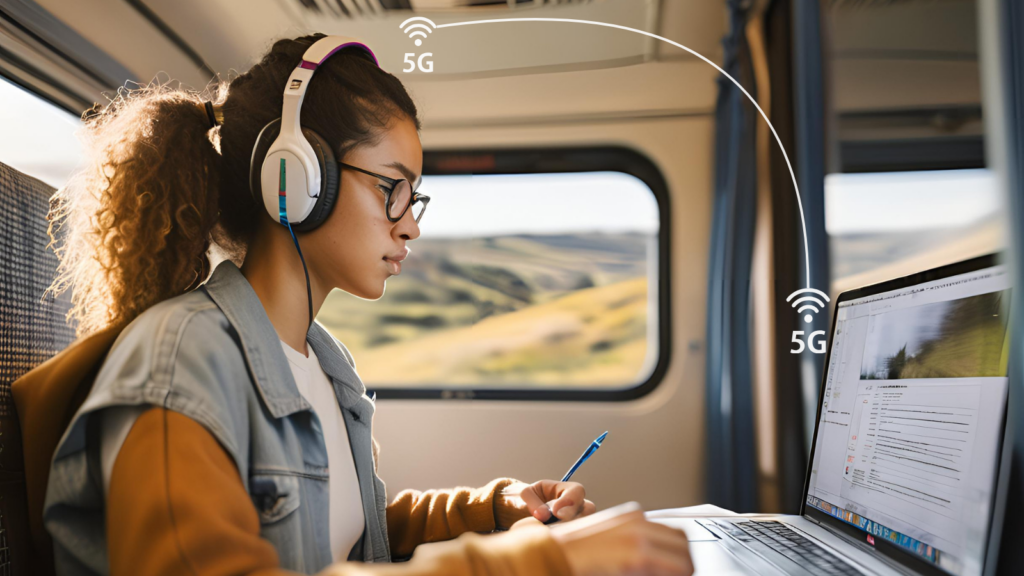Connecting education: the role of 5G in rail networks
As the Private Network supplier for England’s Connected Heartland Programme, AWTG is playing a key role in deploying a new private 5G, Wi-Fi and corresponding IoT network covering the communities and rail corridor between Bicester and Bletchley. AWTG is working closely with the England’s Connected Heartland team to deliver this crucial implementation project. This initiative not only marks a significant advancement in regional connectivity but also underscores the broader transformation of high-speed, reliable rail connectivity in supporting the communities and the education sector, particularly universities in the region.

The power of 5G for rail and learning
5G technology has the potential to revolutionise the rail network by providing faster, more reliable internet access to passengers. This improved connectivity enhances safety, efficiency, and accessibility, but one of the most profound benefits is how it supports education. For university students, faculty, and institutions, seamless internet access while travelling can redefine how education is experienced and delivered.
How students benefit: learning beyond the classroom
For university students, reliable 5G connectivity on trains means more than just staying online—it means greater flexibility in learning. The modern education landscape has been shaped by the pandemic, with online learning becoming an integral part of the student experience. Now, the ability to study, research, and participate in academic activities while on the move will further enrich student life.
In a Jisc 2023/2024 survey of digital experience for university students, it states:
“They (students) especially appreciated the flexibility afforded by online learning and on-demand course content, as well as the possibilities to undertake self-directed learning at their own pace, and the ability to collaborate with others.”
“While there has been a continued shift towards mainly on campus teaching (67% of teaching was mainly on campus), many students preferred an online experience, at least some of the time.”
- Digital classrooms on the move– No longer confined to traditional study spaces, students can participate in virtual lectures, complete coursework, and collaborate on projects while commuting.
- Maximising time efficiency– Long train journeys can now be productive study sessions, allowing students to engage in coursework instead of simply passing the time. The Jisc report also noted that a significant percentage of students (41%) learned in public spaces such as cafes. If trains could guarantee excellent connectivity, they could serve as additional productive public spaces.
- Participation in extracurriculars– Whether it’s joining a university club’s online meeting, attending a virtual guest lecture, or collaborating on a research project, students can stay engaged beyond the physical campus.
- Flexible learning opportunities– Whether catching up on recorded lectures, reading academic articles, or even working on coding assignments, students gain greater flexibility in their studies.
- Improved attendance and engagement– With the ability to join online classes from anywhere, students facing long commutes or unexpected travel disruptions can stay connected to their courses.
How university staff benefit: productivity on the go
Beyond students, university staff—including professors, lecturers, and administrative teams—also gain significant advantages from reliable train connectivity.
- Increased Efficiency– Faculty members can use commute time to prepare lessons, grade assignments, or respond to student inquiries, making better use of their schedules.
- Real-Time Access to University Systems– Administrative staff can monitor and manage institutional operations remotely, ensuring smooth coordination between departments.
- Better Communication– With uninterrupted connectivity, university personnel can join faculty meetings, collaborate with colleagues, or engage in professional development activities while travelling.
Benefits for universities: expanding educational reach
For educational institutions, enhanced train connectivity is more than just a convenience—it’s a strategic advantage. Universities that embrace digital learning already integrate online elements into their courses, and strong transport connectivity can support and expand these efforts.
- Widening access to education– Strong connectivity allows universities to attract students from a broader geographical area, making higher education more accessible to those who live further away.
- Attracting prospective students– Digital accessibility on trains strengthens the appeal of universities that support online and hybrid learning models.
- Advancing digital learning strategies– Universities can explore new educational methods, such as augmented reality (AR) learning experiences, interactive digital content, and AI-driven study tools, all accessible from anywhere, including the train.
- Encouraging more engaged learning– Instead of mindless scrolling, students can utilise their commute for meaningful educational engagement, improving retention and academic performance.
- Enhancing cross-university collaboration– The introduction of 5G on trains presents new opportunities for universities to collaborate more effectively. With stable, high-speed connectivity, students and faculty from different institutions can engage in real-time virtual meetings, access shared research platforms, and work on joint projects while travelling between campuses. Academics can attend remote conferences, participate in live-streamed lectures, and coordinate research partnerships without the constraints of unreliable connections. By removing digital barriers, 5G fosters a more integrated academic ecosystem, particularly between major institutions like those in the Oxford-Cambridge Arc.
5G and student mobility in intercity travel
Beyond urban transit, improved 5G connectivity has significant implications for intercity student mobility. Universities across the UK frequently collaborate on research, offer joint-degree programs, and host inter-university events. Students and faculty often travel between cities for academic conferences, lectures, and networking opportunities. With seamless 5G connectivity on intercity rail routes, students and researchers can:
- Stay productive during long-distance travel– Whether travelling between Oxford and Cambridge or from London to Manchester, students can study, complete assignments, or attend virtual lectures without disruption.
- Support cross-university engagement– Reliable connectivity enables real-time collaboration between universities, supporting joint research projects, virtual study groups, and academic partnerships.
- Enhance access to a wider range of educational opportunities– Students attending online classes or hybrid programs can participate in more flexible study arrangements without being limited by location.
Place branding: strengthening a region’s appeal
Strong digital connectivity enhances the attractiveness of a region—not only for students and university staff but also for businesses, tourists, and remote workers. A well-connected transport network signals innovation and progress, making cities and university towns more appealing destinations for talent and investment.
The Oxford-Cambridge Arc, which includes two of the world’s most renowned universities, is a prime example of how infrastructure improvements can enhance the global appeal of an educational hub. The UK Chancellor’s vision of a ‘growth corridor’ between Oxford and Cambridge aims to boost innovation, business, and education by strengthening transport links. Improved 5G connectivity on rail networks plays a key role in this vision by making these prestigious institutions more accessible to students, researchers, and faculty members commuting between them. By facilitating easier travel and seamless digital engagement, this initiative supports the Arc’s role as a global leader in research, education, and technological advancement.
Conclusion: a smarter future for education and transport
As we move toward an increasingly digital world, ensuring strong, reliable connectivity on trains will be essential for the future of education. While the 5G network our project will be establishing for the Bicester to Bletchley section of East West Rail is a regional pilot project and is designed for a particular type of rail track rather than a blanket solution, the project illuminates how transportation and education can evolve together. By enabling students, staff, and institutions to stay connected, we open doors to more accessible, flexible, and enriching learning experiences. With advanced wireless connectivity, education doesn’t stop when the journey begins—it continues, uninterrupted, on the move.
Stay tuned for more insightful content as we continue exploring the impact of advanced wireless connectivity like 5G on railways, as well as updates about the progress of our this programme’s 5G railway project.

